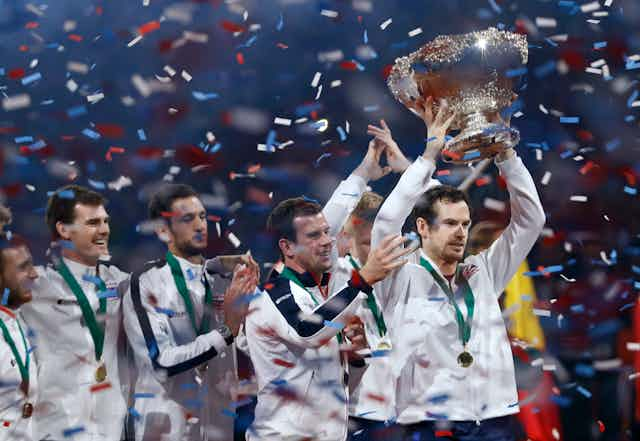After a 79-year wait, Great Britain’s Davis Cup win was an emotional day for the country’s tennis fans, players and, in particular, Andy Murray. Having won all eight of his singles matches in the tournament – a record that matches the likes of John McEnroe and Mats Wilander – he was instrumental in ensuring victory.
Murray’s Grand Slam and Olympic success has without question raised the profile of British tennis in the last few years. While the former golden boy of Wimbledon Tim Henman was popular, he didn’t have the success of Murray on the court. It would be easy to think that this would have led in turn to higher participation rates in the sport, but that has not been the case.
In general terms, sport participation figures have been failing since the London 2012 Olympics, with tennis one of those hit the hardest. This led to a cut of £530,000 for the Lawn Tennis Association (LTA) in 2013.
Trickle-down effect not assured
The LTA, the governing body of tennis in the UK, has been criticised for failing to capitalise on Murray’s Wimbledon victory in 2013. But LTA chief Michael Downey said that victories such as the Davis cup “are very, very special and emotional moments that can drive interest in our sport”. He went on that the sport has “a couple of great weeks of coverage now” which could help increase participation.
But this “trickle down” effect in sport is one which some researchers have dispelled as fundamentally flawed when success and participation rates are investigated more thoroughly.
In the case of tennis, timing may play an issue. Unlike Murray’s 2013 Wimbledon win, December is most certainly not a time of year when tennis is at the forefront of people’s mind, so the LTA already have a challenge on their hands.
A good contrast can be made if we rewind to London 2012 Olympics. One key legacy goal for the games was “to inspire a generation of young people”.
Heptathlete Jessica Ennis-Hill and cyclist Chris Hoy were fundamental in fostering the enthusiasm of a nation and providing excellent role models to a raft of young people – in turn participation rates jumped for both cycling and athletics.
All about access
But tennis may have different drivers. Murray is very much on his own when it comes to raising the profile of British tennis, unlike athletics and cycling which have multiple successful athletes. While the Davis Cup win was a team event the success was in the main down to Murray – and the other players have a much lower profile.
Tennis also carries with it some unique challenges which in part are deep-rooted in the sport’s culture. It is an expensive sport, in which early specialisation is often encouraged. It is also a huge commitment for parents and families both in terms of financial and logistical demands.
It is this combination of commitment, cost and a middle-class image that has led to the current situation within British tennis, with only two British men (Andy Murray and Aljaž Bedene) and two British women (Johanna Konta and Heather Watson) in the current top 100 players in the world. Add to this the funding issues which have impacted on the sport’s facilities, and it becomes a challenge just to find a venue.
As Andy Murray’s mother, Judy, says of her two sons’ access to facilities locally: “If that centre wasn’t there and we’d had to drive 40 or 50 miles to Glasgow or Edinburgh then Andy and Jamie may never have gone down the tennis route.”
Even with the challenges of cost, and facilities, perhaps the bigger issue comes down to the man himself. Andy Murray is unlike Ennis Hill who embraced her role as an ambassador for athletics and identified the impact of role models on athletes.
Murray is at the other end of the curve and has made it clear he thinks his role is on the court. He has attracted some criticism for this from former player and David Cup captain David Lloyd who has accused him of not doing enough to promote the sport – to which Murray responded by posting a video of himself training on Instagram.
Yet while Murray rightly is highly focused on his performance on court, there is an unwritten code that athletes are also role models for the next generation and therefore fundamental to the process of increasing participation rates.
But if the LTA, with Murray’s support, can capitalise on the Davis Cup success there is potential to begin the path towards galvanising a new cohort of future British champions.

